Current Trend in Business Intelligence
VerifiedAdded on 2023/06/15
|8
|1675
|459
AI Summary
This report discusses the current trends in data warehousing, business intelligence, and data mining. It also covers the concepts and principles of predictive analytic software. The report provides insights into how companies like Tesco use these models and concepts to achieve their organizational goals.
Contribute Materials
Your contribution can guide someone’s learning journey. Share your
documents today.
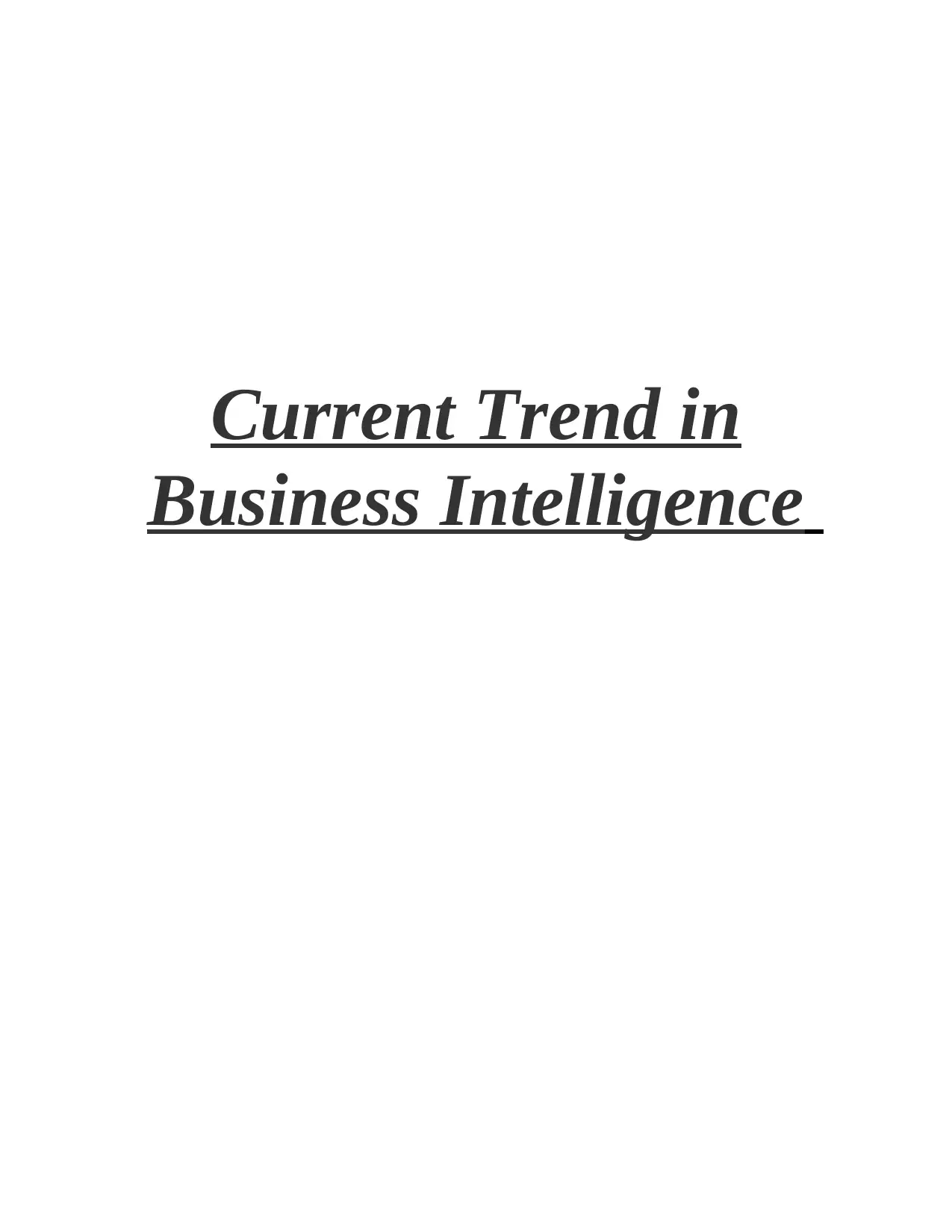
Current Trend in
Business Intelligence
Business Intelligence
Secure Best Marks with AI Grader
Need help grading? Try our AI Grader for instant feedback on your assignments.
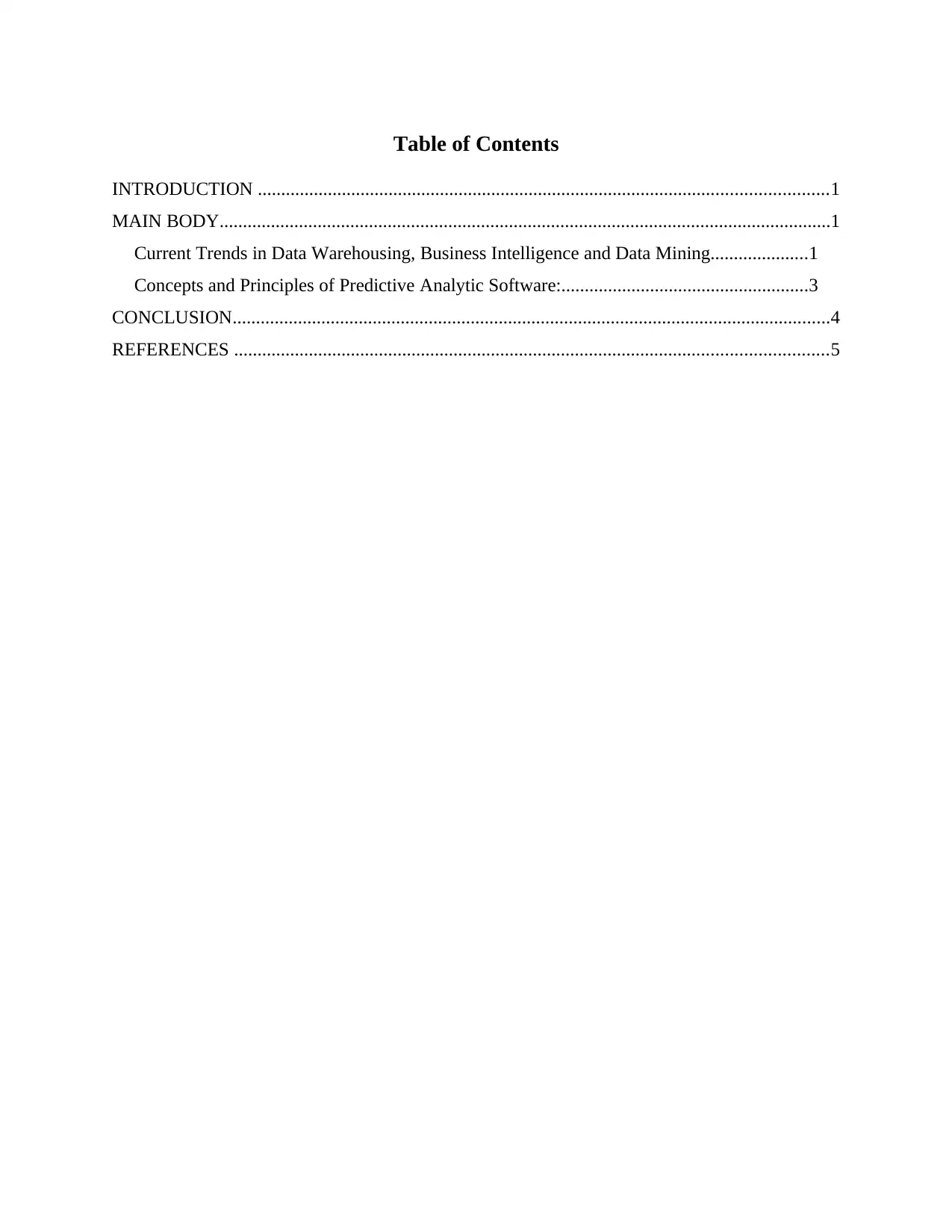
Table of Contents
INTRODUCTION ..........................................................................................................................1
MAIN BODY...................................................................................................................................1
Current Trends in Data Warehousing, Business Intelligence and Data Mining.....................1
Concepts and Principles of Predictive Analytic Software:.....................................................3
CONCLUSION................................................................................................................................4
REFERENCES ...............................................................................................................................5
INTRODUCTION ..........................................................................................................................1
MAIN BODY...................................................................................................................................1
Current Trends in Data Warehousing, Business Intelligence and Data Mining.....................1
Concepts and Principles of Predictive Analytic Software:.....................................................3
CONCLUSION................................................................................................................................4
REFERENCES ...............................................................................................................................5
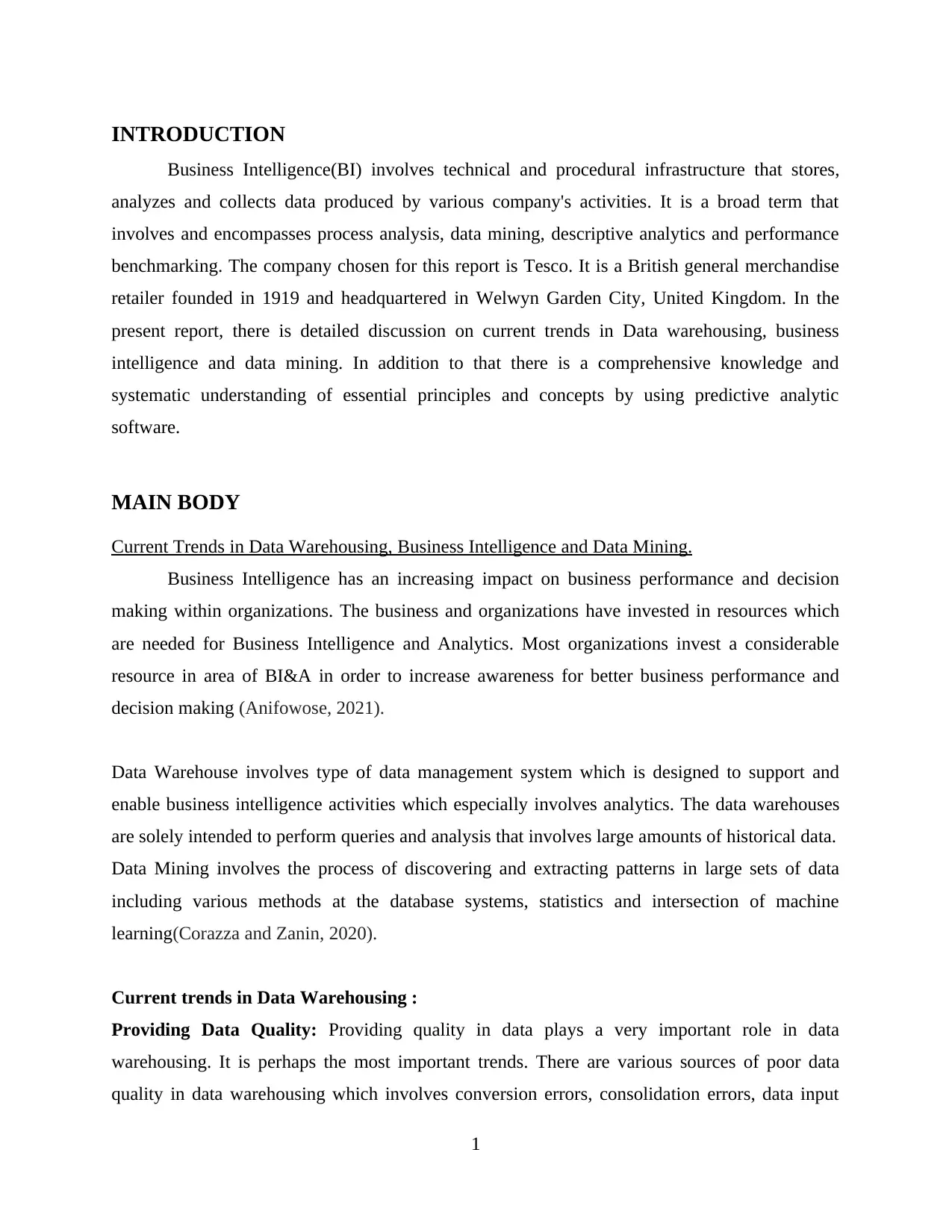
INTRODUCTION
Business Intelligence(BI) involves technical and procedural infrastructure that stores,
analyzes and collects data produced by various company's activities. It is a broad term that
involves and encompasses process analysis, data mining, descriptive analytics and performance
benchmarking. The company chosen for this report is Tesco. It is a British general merchandise
retailer founded in 1919 and headquartered in Welwyn Garden City, United Kingdom. In the
present report, there is detailed discussion on current trends in Data warehousing, business
intelligence and data mining. In addition to that there is a comprehensive knowledge and
systematic understanding of essential principles and concepts by using predictive analytic
software.
MAIN BODY
Current Trends in Data Warehousing, Business Intelligence and Data Mining.
Business Intelligence has an increasing impact on business performance and decision
making within organizations. The business and organizations have invested in resources which
are needed for Business Intelligence and Analytics. Most organizations invest a considerable
resource in area of BI&A in order to increase awareness for better business performance and
decision making (Anifowose, 2021).
Data Warehouse involves type of data management system which is designed to support and
enable business intelligence activities which especially involves analytics. The data warehouses
are solely intended to perform queries and analysis that involves large amounts of historical data.
Data Mining involves the process of discovering and extracting patterns in large sets of data
including various methods at the database systems, statistics and intersection of machine
learning(Corazza and Zanin, 2020).
Current trends in Data Warehousing :
Providing Data Quality: Providing quality in data plays a very important role in data
warehousing. It is perhaps the most important trends. There are various sources of poor data
quality in data warehousing which involves conversion errors, consolidation errors, data input
1
Business Intelligence(BI) involves technical and procedural infrastructure that stores,
analyzes and collects data produced by various company's activities. It is a broad term that
involves and encompasses process analysis, data mining, descriptive analytics and performance
benchmarking. The company chosen for this report is Tesco. It is a British general merchandise
retailer founded in 1919 and headquartered in Welwyn Garden City, United Kingdom. In the
present report, there is detailed discussion on current trends in Data warehousing, business
intelligence and data mining. In addition to that there is a comprehensive knowledge and
systematic understanding of essential principles and concepts by using predictive analytic
software.
MAIN BODY
Current Trends in Data Warehousing, Business Intelligence and Data Mining.
Business Intelligence has an increasing impact on business performance and decision
making within organizations. The business and organizations have invested in resources which
are needed for Business Intelligence and Analytics. Most organizations invest a considerable
resource in area of BI&A in order to increase awareness for better business performance and
decision making (Anifowose, 2021).
Data Warehouse involves type of data management system which is designed to support and
enable business intelligence activities which especially involves analytics. The data warehouses
are solely intended to perform queries and analysis that involves large amounts of historical data.
Data Mining involves the process of discovering and extracting patterns in large sets of data
including various methods at the database systems, statistics and intersection of machine
learning(Corazza and Zanin, 2020).
Current trends in Data Warehousing :
Providing Data Quality: Providing quality in data plays a very important role in data
warehousing. It is perhaps the most important trends. There are various sources of poor data
quality in data warehousing which involves conversion errors, consolidation errors, data input
1
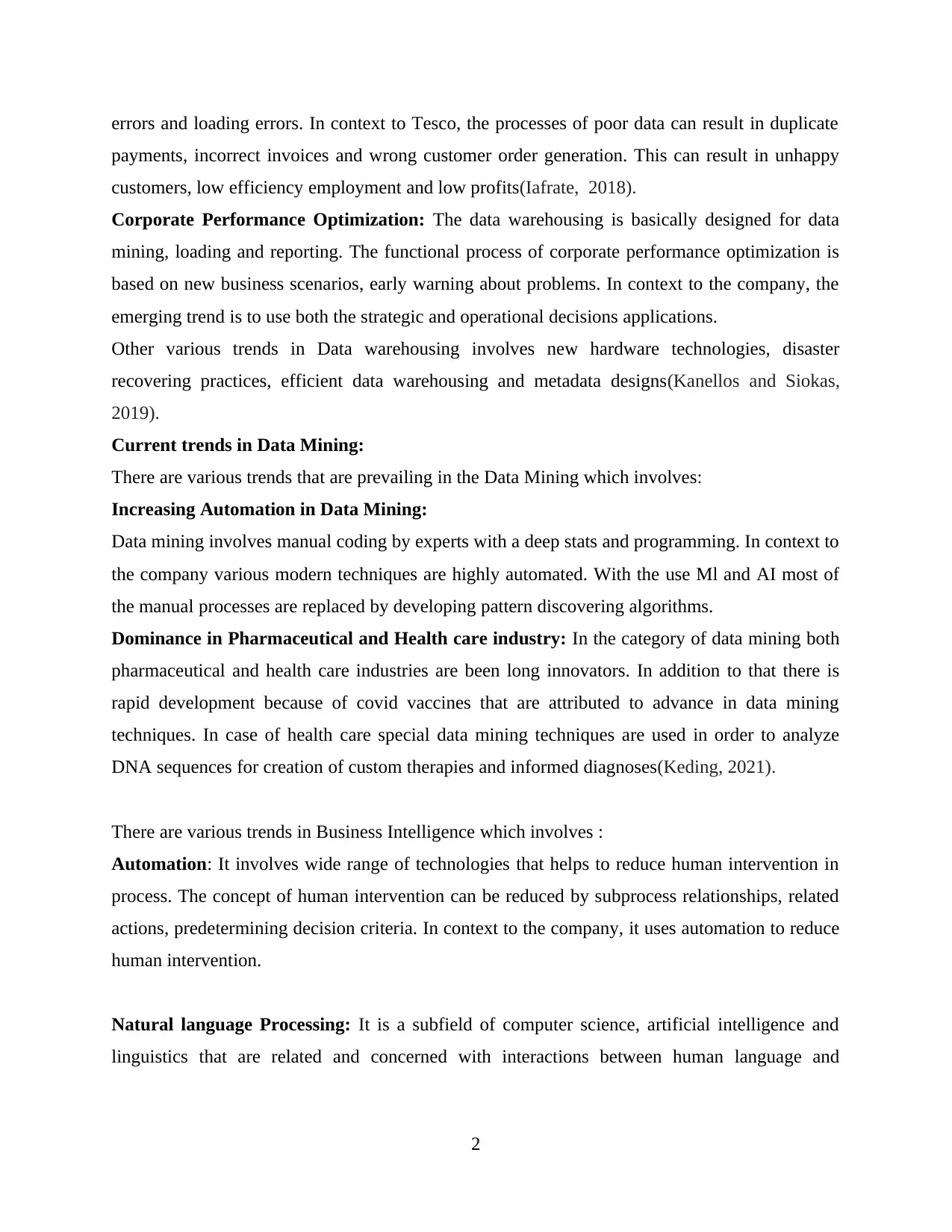
errors and loading errors. In context to Tesco, the processes of poor data can result in duplicate
payments, incorrect invoices and wrong customer order generation. This can result in unhappy
customers, low efficiency employment and low profits(Iafrate, 2018).
Corporate Performance Optimization: The data warehousing is basically designed for data
mining, loading and reporting. The functional process of corporate performance optimization is
based on new business scenarios, early warning about problems. In context to the company, the
emerging trend is to use both the strategic and operational decisions applications.
Other various trends in Data warehousing involves new hardware technologies, disaster
recovering practices, efficient data warehousing and metadata designs(Kanellos and Siokas,
2019).
Current trends in Data Mining:
There are various trends that are prevailing in the Data Mining which involves:
Increasing Automation in Data Mining:
Data mining involves manual coding by experts with a deep stats and programming. In context to
the company various modern techniques are highly automated. With the use Ml and AI most of
the manual processes are replaced by developing pattern discovering algorithms.
Dominance in Pharmaceutical and Health care industry: In the category of data mining both
pharmaceutical and health care industries are been long innovators. In addition to that there is
rapid development because of covid vaccines that are attributed to advance in data mining
techniques. In case of health care special data mining techniques are used in order to analyze
DNA sequences for creation of custom therapies and informed diagnoses(Keding, 2021).
There are various trends in Business Intelligence which involves :
Automation: It involves wide range of technologies that helps to reduce human intervention in
process. The concept of human intervention can be reduced by subprocess relationships, related
actions, predetermining decision criteria. In context to the company, it uses automation to reduce
human intervention.
Natural language Processing: It is a subfield of computer science, artificial intelligence and
linguistics that are related and concerned with interactions between human language and
2
payments, incorrect invoices and wrong customer order generation. This can result in unhappy
customers, low efficiency employment and low profits(Iafrate, 2018).
Corporate Performance Optimization: The data warehousing is basically designed for data
mining, loading and reporting. The functional process of corporate performance optimization is
based on new business scenarios, early warning about problems. In context to the company, the
emerging trend is to use both the strategic and operational decisions applications.
Other various trends in Data warehousing involves new hardware technologies, disaster
recovering practices, efficient data warehousing and metadata designs(Kanellos and Siokas,
2019).
Current trends in Data Mining:
There are various trends that are prevailing in the Data Mining which involves:
Increasing Automation in Data Mining:
Data mining involves manual coding by experts with a deep stats and programming. In context to
the company various modern techniques are highly automated. With the use Ml and AI most of
the manual processes are replaced by developing pattern discovering algorithms.
Dominance in Pharmaceutical and Health care industry: In the category of data mining both
pharmaceutical and health care industries are been long innovators. In addition to that there is
rapid development because of covid vaccines that are attributed to advance in data mining
techniques. In case of health care special data mining techniques are used in order to analyze
DNA sequences for creation of custom therapies and informed diagnoses(Keding, 2021).
There are various trends in Business Intelligence which involves :
Automation: It involves wide range of technologies that helps to reduce human intervention in
process. The concept of human intervention can be reduced by subprocess relationships, related
actions, predetermining decision criteria. In context to the company, it uses automation to reduce
human intervention.
Natural language Processing: It is a subfield of computer science, artificial intelligence and
linguistics that are related and concerned with interactions between human language and
2
Secure Best Marks with AI Grader
Need help grading? Try our AI Grader for instant feedback on your assignments.
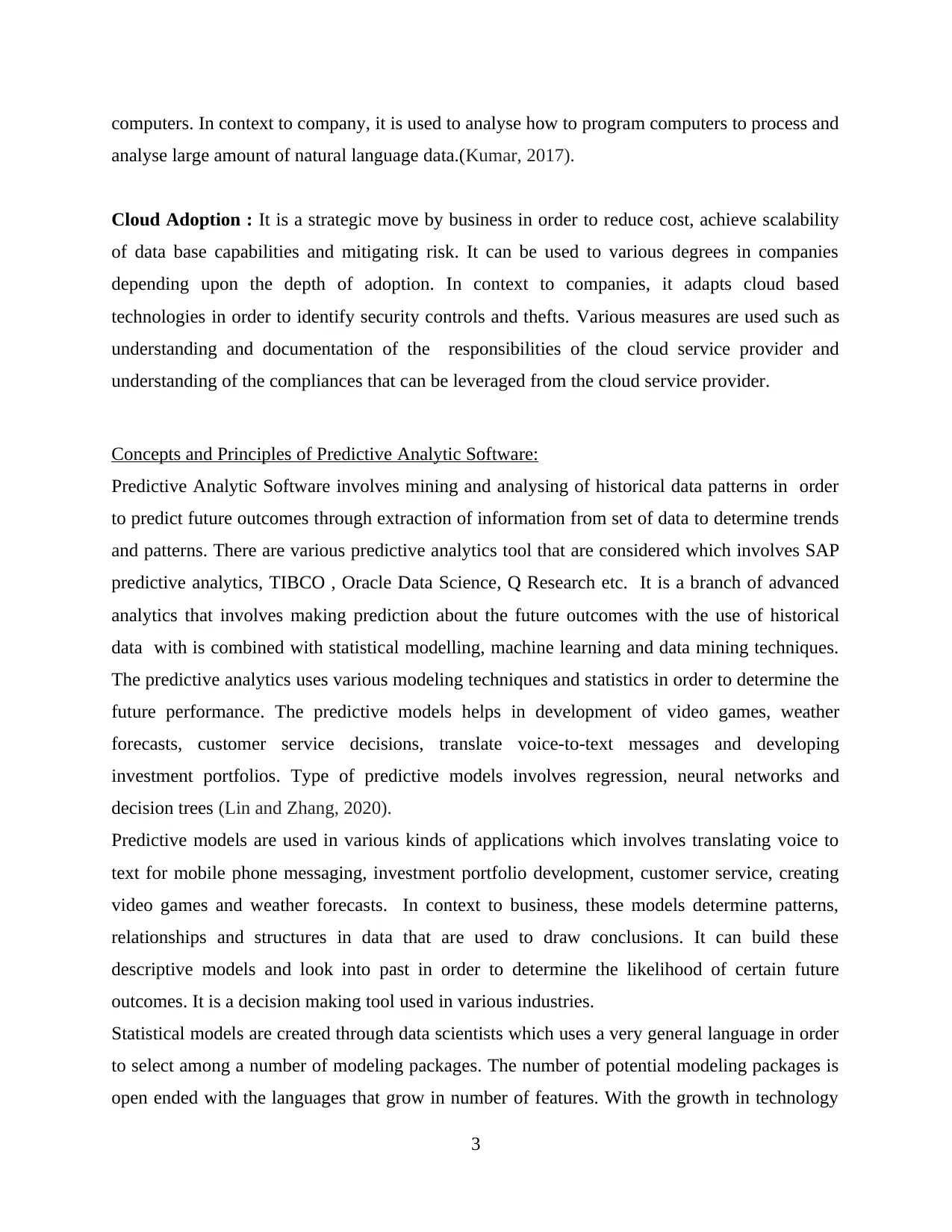
computers. In context to company, it is used to analyse how to program computers to process and
analyse large amount of natural language data.(Kumar, 2017).
Cloud Adoption : It is a strategic move by business in order to reduce cost, achieve scalability
of data base capabilities and mitigating risk. It can be used to various degrees in companies
depending upon the depth of adoption. In context to companies, it adapts cloud based
technologies in order to identify security controls and thefts. Various measures are used such as
understanding and documentation of the responsibilities of the cloud service provider and
understanding of the compliances that can be leveraged from the cloud service provider.
Concepts and Principles of Predictive Analytic Software:
Predictive Analytic Software involves mining and analysing of historical data patterns in order
to predict future outcomes through extraction of information from set of data to determine trends
and patterns. There are various predictive analytics tool that are considered which involves SAP
predictive analytics, TIBCO , Oracle Data Science, Q Research etc. It is a branch of advanced
analytics that involves making prediction about the future outcomes with the use of historical
data with is combined with statistical modelling, machine learning and data mining techniques.
The predictive analytics uses various modeling techniques and statistics in order to determine the
future performance. The predictive models helps in development of video games, weather
forecasts, customer service decisions, translate voice-to-text messages and developing
investment portfolios. Type of predictive models involves regression, neural networks and
decision trees (Lin and Zhang, 2020).
Predictive models are used in various kinds of applications which involves translating voice to
text for mobile phone messaging, investment portfolio development, customer service, creating
video games and weather forecasts. In context to business, these models determine patterns,
relationships and structures in data that are used to draw conclusions. It can build these
descriptive models and look into past in order to determine the likelihood of certain future
outcomes. It is a decision making tool used in various industries.
Statistical models are created through data scientists which uses a very general language in order
to select among a number of modeling packages. The number of potential modeling packages is
open ended with the languages that grow in number of features. With the growth in technology
3
analyse large amount of natural language data.(Kumar, 2017).
Cloud Adoption : It is a strategic move by business in order to reduce cost, achieve scalability
of data base capabilities and mitigating risk. It can be used to various degrees in companies
depending upon the depth of adoption. In context to companies, it adapts cloud based
technologies in order to identify security controls and thefts. Various measures are used such as
understanding and documentation of the responsibilities of the cloud service provider and
understanding of the compliances that can be leveraged from the cloud service provider.
Concepts and Principles of Predictive Analytic Software:
Predictive Analytic Software involves mining and analysing of historical data patterns in order
to predict future outcomes through extraction of information from set of data to determine trends
and patterns. There are various predictive analytics tool that are considered which involves SAP
predictive analytics, TIBCO , Oracle Data Science, Q Research etc. It is a branch of advanced
analytics that involves making prediction about the future outcomes with the use of historical
data with is combined with statistical modelling, machine learning and data mining techniques.
The predictive analytics uses various modeling techniques and statistics in order to determine the
future performance. The predictive models helps in development of video games, weather
forecasts, customer service decisions, translate voice-to-text messages and developing
investment portfolios. Type of predictive models involves regression, neural networks and
decision trees (Lin and Zhang, 2020).
Predictive models are used in various kinds of applications which involves translating voice to
text for mobile phone messaging, investment portfolio development, customer service, creating
video games and weather forecasts. In context to business, these models determine patterns,
relationships and structures in data that are used to draw conclusions. It can build these
descriptive models and look into past in order to determine the likelihood of certain future
outcomes. It is a decision making tool used in various industries.
Statistical models are created through data scientists which uses a very general language in order
to select among a number of modeling packages. The number of potential modeling packages is
open ended with the languages that grow in number of features. With the growth in technology
3

there is a conceptual distance between business and data scientist. There are various basic
principles of Predictive Analytics :
Identify and understand need of Business : It involves the assumption that everything begin
with need of the end user. It involves requirement of understanding and insights that are easily
met through various models built using predictive variable. An univariate model is easily
understood immediately through means of a curve or table(Zhang and Li, 2019).
Be resourceful with automation: It involves modeler through automation with a continuous
multiplication of productivity and efficiency. The multivariate model results in automated,
efficient combining of qualified univariate models. Other decisions can be aided by exploiting
the automation principle.
CONCLUSION
The above report involves the detailed discussion on how Data Handling and Business
Intelligence helps an organization to achieve objectives. In addition to that it involves current
trends in Data warehousing, data mining and business intelligence. Moreover, it involves
concepts and principles of predictive analytic software and how the company and its managers
uses these models and concepts in order to attract customers and achieve organizational goals.
4
principles of Predictive Analytics :
Identify and understand need of Business : It involves the assumption that everything begin
with need of the end user. It involves requirement of understanding and insights that are easily
met through various models built using predictive variable. An univariate model is easily
understood immediately through means of a curve or table(Zhang and Li, 2019).
Be resourceful with automation: It involves modeler through automation with a continuous
multiplication of productivity and efficiency. The multivariate model results in automated,
efficient combining of qualified univariate models. Other decisions can be aided by exploiting
the automation principle.
CONCLUSION
The above report involves the detailed discussion on how Data Handling and Business
Intelligence helps an organization to achieve objectives. In addition to that it involves current
trends in Data warehousing, data mining and business intelligence. Moreover, it involves
concepts and principles of predictive analytic software and how the company and its managers
uses these models and concepts in order to attract customers and achieve organizational goals.
4

REFERENCES
Books and Journals
Anifowose, F. A., 2021, October. Creating Opportunities for Successful Artificial Intelligence
Applications in the Upstream Petroleum Industry. In SPE Symposium: Artificial
Intelligence-Towards a Resilient and Efficient Energy Industry. OnePetro.
Corazza, G. and Zanin, F., 2020. Impact of Artificial Intelligence on Managerial Accounting
Systems. In Handbook of Research on IT Applications for Strategic Competitive
Advantage and Decision Making (pp. 17-35). IGI Global.
Iafrate, F., 2018. Artificial intelligence and big data: The birth of a new intelligence. John Wiley
& Sons.
Kanellos, N. and Siokas, G., 2019, December. Smart Municipalities in Europe and Greece: A
Comparative SWOT Analysis. In International Conference on Business Intelligence &
Modelling (pp. 149-155). Springer, Cham.
Keding, C., 2021. Understanding the interplay of artificial intelligence and strategic
management: four decades of research in review. Management Review Quarterly, 71(1).
pp.91-134.
Kumar, R., 2017. Artificial intelligence—basics. In Machine Learning and Cognition in
Enterprises (pp. 33-49). Apress, Berkeley, CA.
Lin, J. and Zhang, Z., 2020, October. Application Analysis of Big Data in Digital Media. In 2020
2nd International Conference on Machine Learning, Big Data and Business Intelligence
(MLBDBI) (pp. 292-295). IEEE.
Zhang, W. and Li, L., 2019, November. Multi-Dimensional Visualization Analysis of China's
Big Data Research from 2012 to 2019. In 2019 International Conference on Machine
Learning, Big Data and Business Intelligence (MLBDBI) (pp. 225-228). IEEE.
5
Books and Journals
Anifowose, F. A., 2021, October. Creating Opportunities for Successful Artificial Intelligence
Applications in the Upstream Petroleum Industry. In SPE Symposium: Artificial
Intelligence-Towards a Resilient and Efficient Energy Industry. OnePetro.
Corazza, G. and Zanin, F., 2020. Impact of Artificial Intelligence on Managerial Accounting
Systems. In Handbook of Research on IT Applications for Strategic Competitive
Advantage and Decision Making (pp. 17-35). IGI Global.
Iafrate, F., 2018. Artificial intelligence and big data: The birth of a new intelligence. John Wiley
& Sons.
Kanellos, N. and Siokas, G., 2019, December. Smart Municipalities in Europe and Greece: A
Comparative SWOT Analysis. In International Conference on Business Intelligence &
Modelling (pp. 149-155). Springer, Cham.
Keding, C., 2021. Understanding the interplay of artificial intelligence and strategic
management: four decades of research in review. Management Review Quarterly, 71(1).
pp.91-134.
Kumar, R., 2017. Artificial intelligence—basics. In Machine Learning and Cognition in
Enterprises (pp. 33-49). Apress, Berkeley, CA.
Lin, J. and Zhang, Z., 2020, October. Application Analysis of Big Data in Digital Media. In 2020
2nd International Conference on Machine Learning, Big Data and Business Intelligence
(MLBDBI) (pp. 292-295). IEEE.
Zhang, W. and Li, L., 2019, November. Multi-Dimensional Visualization Analysis of China's
Big Data Research from 2012 to 2019. In 2019 International Conference on Machine
Learning, Big Data and Business Intelligence (MLBDBI) (pp. 225-228). IEEE.
5
Paraphrase This Document
Need a fresh take? Get an instant paraphrase of this document with our AI Paraphraser

6
1 out of 8
Related Documents
Your All-in-One AI-Powered Toolkit for Academic Success.
+13062052269
info@desklib.com
Available 24*7 on WhatsApp / Email
![[object Object]](/_next/static/media/star-bottom.7253800d.svg)
Unlock your academic potential
© 2024 | Zucol Services PVT LTD | All rights reserved.





